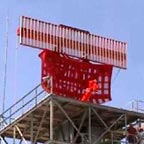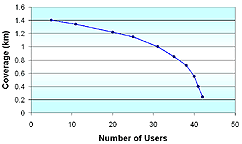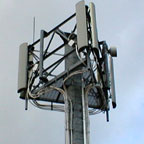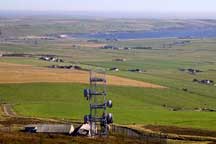Wednesday 16 November, 2005, 07:59 - Radio Randomness
According to an article in yesterday's London 'Metro' newspaper, experts from the highly respected Massachusetts Institute of Technology (MIT) have spent about US$200,000 showing that aluminium hats, similar to those worn by Mel Gibson in the film 'Signs' serve to reduce radio signals at most frequencies, but that some frequencies were amplified by the shiny metal toupees.  The report 'On the Effectiveness of Aluminium Foil Helmets: An Empirical Study' went on to show that the frequencies which were amplified were ones which had been allocated to the US Government and thus concluded that this was some kind of conspiracy to conduct mind control of US citizens.
The report 'On the Effectiveness of Aluminium Foil Helmets: An Empirical Study' went on to show that the frequencies which were amplified were ones which had been allocated to the US Government and thus concluded that this was some kind of conspiracy to conduct mind control of US citizens.However the truth about the MIT study is rather different. The students used equipment worth US$250,000 (rather than spending that much) in the form of a network analyser to determine the gain of the 'hat' at different frequencies. They concluded that the hats had peaks in gain at 1.2 and 2.6 GHz (not surprising if one does a few simple sums concerning the typical size of a human head and the frequency at which such hats would naturally resonate) and went on to conclude that as the first of these frequencies was used by GPS satellites broadcasting Government signals from the sky, that the hats may well increase the Government's invasive abilities.
If this were to be the case, then the US Government would have to emit high power 'mind-altering' signals on those frequencies. However, much more importantly, they would have to make all the citizens wear silly aluminium hats, which as far as I am aware is not yet mandatory (except, presumably, at some of the more wacky parties at MIT!)
Further, GPS satellite signals are very weak compared to the extremely high-powered
 aeronautical radar systems that share the frequencies around 1.2 GHz, so if any signal were likely to affect the wearer it would be those coming from the radars at airports (and the corresponding transponders on aircraft). Aeronautical radars (both civil and military) also occupy frequencies beginning at 2.7 GHz (very close to the other measured gain hot-spot).
aeronautical radar systems that share the frequencies around 1.2 GHz, so if any signal were likely to affect the wearer it would be those coming from the radars at airports (and the corresponding transponders on aircraft). Aeronautical radars (both civil and military) also occupy frequencies beginning at 2.7 GHz (very close to the other measured gain hot-spot).  Could this explain the increase in the number of air travellers around the world? Or might it explain why, after a long flight, you feel dazed as you depart the airport? Or is this a conspiracy to increase the sales of duty free?
Could this explain the increase in the number of air travellers around the world? Or might it explain why, after a long flight, you feel dazed as you depart the airport? Or is this a conspiracy to increase the sales of duty free?Why not try wearing one of the hats the next time you visit an airport and see if you can note any unusual effects? Remember not to take it off when you pass through the airport scanners, otherwise the experimental value of the research will be lost. Wearing camouflage, a head scarf and carrying a replica AK-47 are also known to enhance the effectiveness of such airport-based experiments and often make the results more immediate and obvious.
add comment
( 1309 views )
| permalink
| 



 ( 2.9 / 9155 )
( 2.9 / 9155 )




 ( 2.9 / 9155 )
( 2.9 / 9155 )
Tuesday 15 November, 2005, 07:44 - Spectrum Management
CDMA - Code Division Multiple Access - is probably one of the most complex methods for accessing the radio spectrum that is in use today. Let's first take a look at the easier to understand methods to see what the differences are.FDMA - Frequency Division Multiple Access - is a system whereby different users use different frequencies at the same time. Imagine tuning up and down the FM dial, there are lots of stations you can hear but you can separate one from the other by tuning into the different frequencies that each uses. If two occupy the same frequency at the same time, they cause interference to each other and the whole thing falls to pieces.
TDMA - Time Division Multiple Access - is a system whereby different users use the same frequency at different times. So a number of users messages are scheduled one after the other, so that they can all share the same frequency. Imagine a lot of letters passing along the conveyor belt in a postal sorting office. Each message passes after the other along the same conveyor and can be sorted out back into individual messages for delivery. If two letters were to be in the same place at the same time they would crash into each other and the system would fail. From a radio perspective this works only if you take the message concerned and 'squash' or 'compress' it into less time than it would normally take so that at the receiving end it can be de-compressed to fill in the gap that is produced whilst the other messages are being sent.
CDMA is a system whereby all the users use the same frequency at the same time. How can this possibly work without interference being caused? It works by assigning each message a unique code. Think of it as assigning each message a different language and then place yourself in a room where you can hear all the messages together - the one you immediately understand is the one in the language you speak. So if you hear 'Je m'appelle Colin', 'Ich heisse Lyon' and 'My name is Derek', all spoken at the same time, the clearest message is the one in your native language. However this only works if all the messages are roughly the same volume (and in fact works best if all the messages are exactly the same volume), if one language is shouted a lot louder than the others, it inevitably swamps the listener so that he can no longer hear his natural language.
As such, one element of a CDMA radio system is that the receiver (listener) needs to inform all the transmitters (speakers) how strong their signal is (how loud they are being heard) so that the transmitters can adjust their transmitter power (volume) to allow the receiver to hear them all at the same strength. This system of 'power control' is one of the key technologies that allows CDMA systems to operate.
 CDMA receivers also suffer from something called 'cell breathing'. Imagine that you can hear 4 different languages, the chances are that you will hear the one you understand quite easily. Now imagine you can hear 64 languages, it becomes much more difficult to hear your native language. So the more transmitters sharing the same frequency, the harder the receiver has to listen. To compensate for this, receivers move closer together and further apart each and every second to make sure that they are sufficiently near to those transmitters they are receiving to hear them well. Clearly this is not possible and what happens is that the coverage of the cell shrinks when it is heavily loaded, complicating coverage planning.
CDMA receivers also suffer from something called 'cell breathing'. Imagine that you can hear 4 different languages, the chances are that you will hear the one you understand quite easily. Now imagine you can hear 64 languages, it becomes much more difficult to hear your native language. So the more transmitters sharing the same frequency, the harder the receiver has to listen. To compensate for this, receivers move closer together and further apart each and every second to make sure that they are sufficiently near to those transmitters they are receiving to hear them well. Clearly this is not possible and what happens is that the coverage of the cell shrinks when it is heavily loaded, complicating coverage planning.All this being said, CDMA is reckoned to be around twice as spectrally efficient as either TDMA or FDMA techniques, meaning twice as much traffic (data) can be carried in a given amount of spectrum.
 It is no surprise, therefore, that all of the competing third generation (3G) mobile phone technologies use CDMA: the US-based CDMA-1x series of specifications designed by Qualcomm; the European W-CDMA (Wideband-CDMA) or UMTS (Universal Mobile Telecommunications System) system; and the Chinese TD-SCDMA (Time Division-Synchronised CDMA) system.
It is no surprise, therefore, that all of the competing third generation (3G) mobile phone technologies use CDMA: the US-based CDMA-1x series of specifications designed by Qualcomm; the European W-CDMA (Wideband-CDMA) or UMTS (Universal Mobile Telecommunications System) system; and the Chinese TD-SCDMA (Time Division-Synchronised CDMA) system.What's interesting is that although all 3G mobile technologies use CDMA, other mobile technologies (such as Digital Audio Broadcasting, Wireless LAN and HiperLAN) have forgone the use of CDMA and instead use another spectrum access technique called OFDM - Orthogonal Frequency Division Multiplex. But that's a story for another day.
Monday 14 November, 2005, 15:19 - Broadcasting
Look at any Frequency Allocation Table (FAT) whether it's the ITU's radio regulations or a national one and there are lots of places where the use of the spectrum changes from one type to another (for example from mobile to fixed links). But what actually happens at the place where the transition takes place? The frequency which marks the transition point between two bands (or sub-bands) is unusable by the users who occupy the spectrum either side. Let's take an example... A stereo FM broadcast transmission occupies a bandwidth of just over 250 kHz. A transmission on a frequency of 108 MHz (the band edge) would therefore have half, i.e. 125 kHz of its bandwidth inside the broadcast allocation and half inside the neighbouring (aeronautical radionavigation) band. Indeed even an FM transmission on 107.9 MHz would still occupy 25 kHz of spectrum above 108 MHz.
 So who can or does use these 'no man's land' frequencies? Well in theory, no-one can, without contravening the band plan that has been put in place. But people do! In fact these frequencies (and those in the neighbourhood) are often occupied by some of the more 'interesting' signals you will find scattered across the radio spectrum.
So who can or does use these 'no man's land' frequencies? Well in theory, no-one can, without contravening the band plan that has been put in place. But people do! In fact these frequencies (and those in the neighbourhood) are often occupied by some of the more 'interesting' signals you will find scattered across the radio spectrum.Around the edges of the broadcasting bands is where you will often find pirate and clandestine stations: the frequency range 6200 - 6300 kHz has long been a short-wave pirate favourite. Such stations typically use much less power than traditional broadcast stations and as such could not compete if they had to battle alongside the MegaWatt signals from stations such as the BBC and Deustche Welle. However at the edge of the band where no-one lives and there are no signals, it's much easier to be heard. Take a look at some of the other frequencies used by pirate stations and you'll almost universally find that they sit roughly on the border between broadcast and non-broadcast users (Laser Hot Hits on 4025 and 9385 kHz for example).
However even the 'big boys' recognise the benefit of sitting in the quiet no man's land at the edge of the broadcast bands. Vatican Radio uses 1611 kHz (edge of the medium wave band); Radio Prague sit on 6200 kHz (edge of the 49 metre band);
 and Radio Pyongyang (North Korea) inhabit both 7100 and 15100 kHz (edge of the 41 and 25 metre bands respectively). Whilst in theory these stations are operating as 'illegally' as the pirates, spewing interference onto other services, they get away with it by the fact that they are 'internationally recognised'.
and Radio Pyongyang (North Korea) inhabit both 7100 and 15100 kHz (edge of the 41 and 25 metre bands respectively). Whilst in theory these stations are operating as 'illegally' as the pirates, spewing interference onto other services, they get away with it by the fact that they are 'internationally recognised'.Take a tune around the band edges (not just the broadcast bands but other ones too) and see what you find...
Friday 4 November, 2005, 23:20 - Much Ado About Nothing
A lot has been made in the British press recently of a test which is being introduced by the Home Office to assess immigrants' knowledge of Britain - the 'Britishness Test'. Amongst the many peculiar questions raised in the test, newspapers and television channels alike have reported with surprise that in the UK there are two numbers which can be used to call the emergency services (police, fire, ambulance and coastguard): 999 and 112. Most UK residents would be able to tell you that 999 is an emergency number, however few, if any, would be aware of the existence of the second option, 112. Which is quite amazing when you consider that 112 has been an emergency number in the UK for nearly 15 years. It stems from one of the (in my opinion) more sensible European Commission decisions (91/396/EEC) which requires all European Union (EU) Member States to adopt 112 as an emergency number by 31 December 1992. At the same time, the international access code was harmonised across EU countries to be 00 through a sister decision (92/264/EEC) to be implemented in the same time-frame.
Most UK residents would be able to tell you that 999 is an emergency number, however few, if any, would be aware of the existence of the second option, 112. Which is quite amazing when you consider that 112 has been an emergency number in the UK for nearly 15 years. It stems from one of the (in my opinion) more sensible European Commission decisions (91/396/EEC) which requires all European Union (EU) Member States to adopt 112 as an emergency number by 31 December 1992. At the same time, the international access code was harmonised across EU countries to be 00 through a sister decision (92/264/EEC) to be implemented in the same time-frame.The great thing about 112 is that you can use it in any EU country to get through to the emergency services, regardless of which country you are in. Of course if you don't happen to speak Czech, Slovenian or Estonian, this may be of limited use but it's a nice idea. And if you're visiting London you're in luck as the Metropolitan Police's call centre which handles emergency calls have been trialling a system which allows them to deal with calls in 150 different languages, particularly those which reflect the diverse ethnic make-up of this sceptred isle (Portuguese, Turkish, Punjabi, Spanish, French and Somali being the most common in London).

